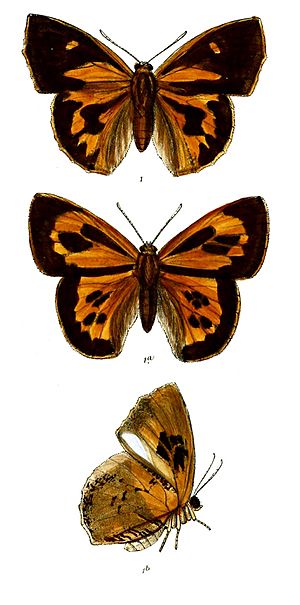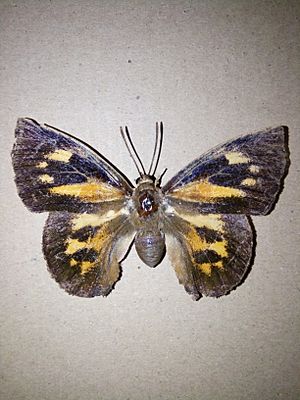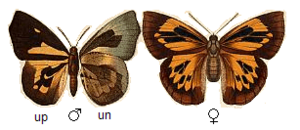Moth butterfly facts for kids
Quick facts for kids Moth butterfly |
|
|---|---|
 |
|
| Male (top), female and male underside | |
 |
|
| L. b. robusta, female from Ombulodata, North Gorontalo, Sulawesi | |
| Scientific classification | |
| Kingdom: | |
| Phylum: | |
| Class: | |
| Order: | |
| Family: | |
| Genus: |
Liphyra
|
| Species: |
L. brassolis
|
| Binomial name | |
| Liphyra brassolis Westwood 1864
|
|
The Liphyra brassolis, also known as the moth butterfly, is a fascinating butterfly found in parts of South Asia, Southeast Asia, and Australia. It belongs to the lycaenid family, which includes many small to medium-sized butterflies. What makes this butterfly truly special is its diet: its young, called larvae or caterpillars, are predators that eat ant larvae!
This moth butterfly is one of the largest species in the lycaenid family. It's not a common butterfly, so finding one is quite rare. Because of this, many butterfly collectors really want to add specimens of this species to their collections.
Contents
About the Moth Butterfly
The moth butterfly has a unique look that helps it survive. Its body is quite strong and heavy, similar to some other large butterflies. Its wings have a special shape, with the front wings being somewhat arched and the back wings looking a bit like a pear. This unique shape and its sturdy body are part of what makes it stand out from other butterflies.
Amazing Habits
The moth butterfly has some truly amazing habits! It actually grows up inside the nests of ants, especially tree ants like the green tree ant (Oecophylla smaragdina).
When an adult moth butterfly first comes out of its pupa, it's covered in a special grey, powdery dust. This dust acts like a shield, protecting the butterfly from the ants living in the nest. The female butterfly lays her tiny, pale green, cylinder-shaped eggs, usually one by one or in small groups, on the underside of branches near an ant nest.
Where It Lives
You can find the moth butterfly in many places, from India all the way to the Philippines. It also lives along the tropical coasts of Western Australia, the Northern Territory, and Queensland in Australia.
Life Cycle
The life cycle of the moth butterfly is very unusual, especially compared to other butterflies.
Egg Stage
The eggs of the moth butterfly are quite large for a lycaenid butterfly. They are green with white patterns and look a bit like a small drum or cylinder. The top of the egg has a cool pattern of tiny hexagons. The sides are covered in white and have about 45 vertical ridges.
Larva Stage (Caterpillar)
The caterpillar of the moth butterfly is oval-shaped, flat, and looks a bit like a slug. It has a hard, smooth outer shell. These caterpillars are fierce eaters and can devour entire groups of ant larvae from a green ant nest!
Their tough, orange shell is almost impossible for soldier ants to bite through. It's also so heavy that the ants can't flip the caterpillar over to get to its soft underside.
Once the caterpillar changes into a butterfly inside the ant nest, its body becomes soft and vulnerable. However, the newly emerged butterfly is protected by white scales from its new wings. These scales are very slippery, making it hard for ants to grab hold. Plus, if ants do get some scales on their jaws, it can confuse and distract them, giving the butterfly time to escape the nest quickly.
Pupa Stage
The pupa is the stage where the caterpillar transforms into a butterfly. Inside the ant nest, the pupa lies freely, not attached to anything. It has a special shape that fits perfectly onto the shed skin of the caterpillar. When the butterfly is ready to emerge, the caterpillar's skin cracks open in a specific way, allowing the new butterfly to come out.


